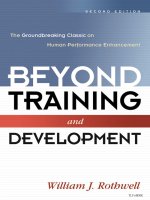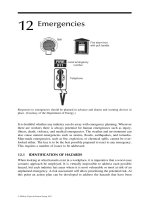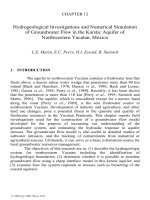Employee training and development 5th chapter 12
Bạn đang xem bản rút gọn của tài liệu. Xem và tải ngay bản đầy đủ của tài liệu tại đây (621.95 KB, 34 trang )
Chapter 12
Special Challenges in Career
Management
McGraw-Hill/Irwin
Copyright © 2010 by the McGraw-Hill Companies, Inc. All rights reserved.
Introduction
Supportive work-life culture
Acknowledges and respects family and life
responsibilities and obligations.
Encourages managers and employees to work
together to meet personal and work needs.
12-2
Socialization and Orientation
Organizational socialization – the
process by which new employees are
transformed into effective members of
the company; has three phases:
Anticipatory socialization - employees
develop expectations about the company, job,
working conditions, and interpersonal
relationships.
12-3
Socialization and Orientation
(cont.)
Encounter phase - employee begins a new
job; they experience shock and surprise and
need to become familiar with job tasks,
company practices, procedures, etc.
Settling-in phase - employees begin to feel
comfortable with their job demands and social
relationships.
12-4
Table 12.1 - What Employees Should Learn
and Develop Through Socialization
12-5
Table 12.2 - Content of
Orientation Programs
12-6
Table 12.3 - Characteristics of
Effective Orientation Programs
12-7
Career Paths, Developing DualCareer Paths and Career Portfolios
Career path - a sequence of job
positions involving similar types of work
and skills that employees move through
in the company; it involves analyzing:
work and information flows.
important development experiences.
qualifications and tasks performed across
jobs.
similarities and differences in working
environments.
historical movement patterns of employees in
and out of jobs.
12-8
Career Paths, Developing Dual-Career
Paths and Career Portfolios (cont.)
Dual-career path system - enables
employees to remain in a technical career
path or move into a management career
path. Its characteristics are:
Salary, status, and incentives for technical
employees compare favorably with those of
managers.
Individual contributors’ base salary may be
lower than that of managers, but they are
given opportunities to increase their total
compensation through bonuses.
12-9
Career Paths, Developing Dual-Career
Paths and Career Portfolios (cont.)
The individual contributor career path is not
used to satisfy poor performers who have no
managerial potential. The career path is for
employees with outstanding technical skills.
Individual contributors are given the
opportunity to choose their career path.
12-10
Figure 12.3 - Example of DualCareer-Path System
12-11
Career Paths, Developing Dual-Career
Paths and Career Portfolios (cont.)
Career portfolio - multiple part-time
jobs that together make up a full-time
position.
Advantages:
Increases job satisfaction and provides flexibility.
Disadvantages:
Stalled earnings and trouble maintaining companysponsored health care.
Readjustment each time the employee moves from
one job to the other.
12-12
Plateauing
The likelihood of the employee receiving
future job assignments with increased
responsibility is low.
Mid-career employees are most likely to
plateau.
It becomes dysfunctional when the employee
feels stuck in a job that offers no potential for
personal growth resulting in poor job attitude,
increased absenteeism, and poor job
performance.
12-13
Plateauing (cont.)
Reasons for employees to plateau:
Discrimination based on age, gender, or race.
Lack of ability and training.
Low need for achievement.
Unfair pay decisions or dissatisfaction with
pay raises.
Confusion about job responsibilities.
Slow company growth resulting in reduced
development opportunities.
12-14
Table 12.4 - Possible Remedies for
Plateaued Employees
12-15
Skills Obsolescence
It is a reduction in an employee’s
competence resulting from a lack of
knowledge of new work processes,
techniques, and technologies that have
developed since the employee completed
his or her education.
12-16
Figure 12.4 - Factors Related to
Updating Skills
12-17
Coping With Career Breaks
Uniformed Services Employment and
Reemployment Rights Act - deployed
employees’ rights, such as guaranteeing
reservists’ jobs when they return, except
under special circumstance.
Companies must ensure that returning
reservists are provided with career
counseling and information on jobs and
career opportunities.
12-18
Balancing Work and Life
Family and Medical Leave Act (FMLA)
- a federal law that provides for up to 12
weeks of unpaid leave for parents with
new infants or newly adopted children.
Also covers employees who must take a leave
of absence to care for a family member or to
deal with a personal illness.
Companies are required to provide health care
benefits.
12-19
Balancing Work and Life (cont.)
Role of training in balancing work and
nonwork:
Trainers and managers may be responsible for
developing policies and procedures.
Trainers may be responsible for developing
training programs to teach managers their
role in administering and overseeing the use
of work-life policies.
12-20
Balancing Work and Life (cont.)
Types of work-life conflict
Time-based conflict - occurs when the
demands of work and nonwork interfere with
each other.
Strain-based conflict - results from the
stress of work and nonwork roles.
Behavior-based conflict - occurs when
employees’ behavior in work roles is not
appropriate for their behavior in nonwork
roles.
12-21
Company Policies to
Accommodate Work and Nonwork
Identifying work and life needs and
communicating information about work
and non-work policies and job demands
Companies have to understand employees’
needs, solicit their input, and make work-life
benefits accessible to everyone.
Providing information regarding the nature of
jobs helps employees choose career
opportunities that match the importance they
place on work.
12-22
Company Policies to Accommodate
Work and Nonwork (cont.)
Flexibility in work arrangements and work
schedules
Reduce pressure on employees to work long
hours.
Telecommuting - a work arrangement that
provides flexibility in both location and hours.
Job sharing - two employees divide the hours,
responsibilities, and benefits of a full-time job.
12-23
Table 12.6 - Alternative Work
Schedules and Work Arrangements
12-24
Company Policies to Accommodate
Work and Nonwork (cont.)
Redesigning jobs
Managerial support for work-life policies
Dependent care support: child and elder
care and adoption support
12-25









